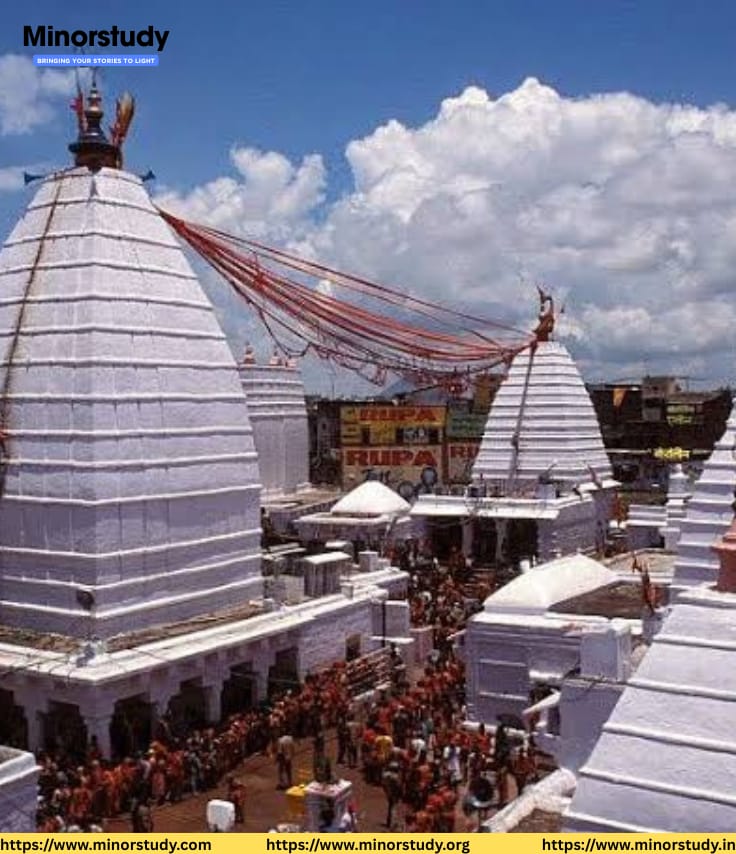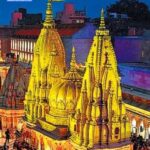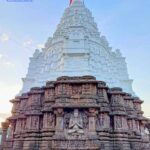7 Astonishing Reasons Why Baidyanath Temple Will Amaze You – History, Facts & Significance
🛕 Introduction: The Divine Healer of Lord Bholenath
Baidyanath Temple: Nestled in the sacred town of Deoghar, in Jharkhand, stands the revered Baidyanath Temple, also known as Baba Dham or Vaidyanath Jyotirlinga—a temple of healing, faith, and profound devotion. One of the 12 Jyotirlingas (self-manifested Shiva shrines), Baidyanath holds immense spiritual power and cultural resonance. This place isn’t merely a religious site—it’s a lifeline for seekers, healers, and devotees who come seeking solace, spiritual awakening, and divine remedies.
- 🛕 Introduction: The Divine Healer of Lord Bholenath
- 📜 Mythology & Ancient Origins
- 📅 Timeline of Sacred Events
- 🧱 Facts That Make Baidyanath Stand Out
- 🌟 Spiritual Significance & Observances
- 💬 Frequently Asked Questions (FAQs)
- Q1. Is Baidyanath Temple same as Baba Dham?
- Q2. How can I reach the temple?
- Q3. When should I visit?
- Q4. Why do devotees carry small cups of water?
- Q5. Are there specific rituals for healing?
- 🙏 Wishing & Blessings for Pilgrims
- 🌱 Impact on Daily Life & Society
- 1. Spiritual Well‑Being
- 2. Social Healing
- 3. Economic Powerhouse
- 4. Cultural Unity
- 5. Environmental Awakening
- 🔍 Important Points to Remember
- 💡 Life Lessons from Lord Baidyanath
- 🧭 Conclusion: A Healing Haven in a Hurried World
- 🔗 Next Steps if You’re Planning the Visit
In this friendly, conversational, and deeply human narrative, we’ll explore everything—from its mythic roots to modern-day relevance, along with FAQs, spiritual significance, life lessons, and concluding reflections on how it shapes daily life and society. So get comfortable, breathe in the faith, and let’s journey into the heart of Baba Dham.
📜 Mythology & Ancient Origins
1. The Healing Sage & Demonic Cause
According to legend, Lord Shiva took on the role of Vaidya (physician) and healed Ravana’s severed head after the Lanka king was mortally wounded in battle. Impressed by Ravana’s devotion, Shiva remained in this land to continue dispensing divine medicine to humanity—hence the name “Baidyanath” (Lord of Physicians).
2. Pandavas & the Jyotirlinga
Another story links the temple to the Pandavas from the Mahabharata. They wanted to atone for their war sins, so they worshiped Shiva here to cleanse their souls—a recurring theme in many Jyotirlinga temples.
3. Reverberations Through Time
Though ancient origins are shrouded in legend, the current stone temple was constructed between the 9th–12th centuries CE, with later expansions under kings and landlords including Ganga dynasty and Nagvanshi rulers.
📅 Timeline of Sacred Events
| Period | Key Development |
|---|---|
| Mythical Era | Shiva heals Ravana; Vaidyanath established |
| 4th–8th Cent. CE | Early pilgrims visit site |
| 9th–12th Cent. CE | Major stone temple built |
| 12th–14th Cent. CE | Upgrades under regional rulers |
| 17th–18th Cent. CE | Baths, shrines, and structures added |
| Early 20th Cent. | Temple restoration by local elites |
| Present Day | Massive pilgrimage site, especially during Sawan |
🧱 Facts That Make Baidyanath Stand Out
12th Jyotirlinga: A haven of spiritual power, one of the most revered Shiva shrines.
Healing Powers: Devotees believe their prayers, especially during Sawan Sombar (Mondays in the month of Shravan), bring physical and mental healing.
Biman Temple Complex: The main Baidyanath temple is part of a vast complex featuring dozens of subsidiary shrines.
Sacred Bael Leaves: Five Bilva leaves are offered to Shiva Linga, considered supremely auspicious.
Sawan Yatra Pilgrimage: More than 800,000 devotees flock to the temple during Shravan Mondays, making it an extraordinary spiritual festival.
304 Steps: The ascent to the temple is made via a flight of stairs—literally a spiritual climb.
Natural Scenery: Deoghar lies amid tranquil hills and lush landscapes—inviting worship and reflection.
🌟 Spiritual Significance & Observances
1. Curing the Unseen & Seen
The name Baidyanath literally means Lord Healer. Many come expecting cures; whether for body or mind, the temple promises a spiritual remedy above all.
2. Maha Shivaratri & Shravan Mondays
Maha Shivaratri draws lakhs who believe staying awake and chanting Shiva’s name during this night brings divine favor.
Shravan Mondays hold unparalleled significance—rituals, fasts, pilgrimages—all in hopes of channeling Lord Shiva’s healing power.
3. Rituals & Practices
Nabhikhand Pooja (Rice Path): A sacred ritual believed to magnify healing.
Mathurakali Vrata: Observed by women seeking blessings for marital bliss and healing.
Angarak Somvar: When Shravan Monday aligns with Mars, considered especially potent.
💬 Frequently Asked Questions (FAQs)
Q1. Is Baidyanath Temple same as Baba Dham?
A: Yes! Baidyanath, Baba Dham, and Vaidyanath Jyotirlinga all refer to this revered temple in Deoghar.
Q2. How can I reach the temple?
A: Deoghar is well-connected by road and rail from major cities in Jharkhand and Bihar. The nearest airport is Patna (~220 km). From Deoghar station, it’s a short auto or cycle ride to the temple.
Q3. When should I visit?
A: Shravan Mondays (usually July–August) mark the busiest pilgrimage period. For a quieter experience, visit between November and February.
Q4. Why do devotees carry small cups of water?
A: It’s part of an ancient vow—carrying holy water from the Ganges to pour on the Linga, believed to cure ailments.
Q5. Are there specific rituals for healing?
A: Yes. Devotees perform Nabhikhand Pooja, offer Bael leaves, chant the Shiva Panchakshari Mantra, and undertake fasting to beseech healing.
🙏 Wishing & Blessings for Pilgrims
If someone you know is making the journey to Baba Dham:
“May Baba Bholenath heal your body, calm your mind, and elevate your soul. Sawan Sombar ke is divya yatra ke liye शुभकामनाएं!”
Or simply recite:
“Om Namah Shivaya! Har Har Mahadev!”
🌱 Impact on Daily Life & Society
1. Spiritual Well‑Being
People report deep mental relief, a sense of renewal, and peace of mind—especially after personal trials.
2. Social Healing
The spiritual atmosphere encourages community bonding—strangers share food, vows, sorrows, and joys.
3. Economic Powerhouse
Pilgrim inflow supports local vendors, guides, lodging businesses, and transport providers, lifting whole segments of society.
4. Cultural Unity
Devotees from multiple states, languages, and traditions unite under one roof of faith, fostering social harmony.
5. Environmental Awakening
Deoghar’s serene landscapes and temple sacredness promote eco-awareness—many pilgrims advocate cleanliness and planting trees after their visit.
🔍 Important Points to Remember
Plan around Shravan Mondays if you want to experience the peak fervor, but be ready for crowds.
Stay hydrated and rest well; the lines and heat can be taxing.
Carry eco-friendly provisions—plastic pollution is a concern in the holy precincts.
Respect local customs, bow head, whisper your prayers, and let the energy lift you.
💡 Life Lessons from Lord Baidyanath
Healing through Faith – Beyond medicine, faith has deep power.
Resilience – The temple’s centuries‑old presence mirrors every devotee’s resilience.
Community Care – Pilgrims learning to share, help, and bond shows spiritual society at its best.
Nature is Sacred – Amid natural beauty, one learns that caring for the earth is a spiritual practice.
🧭 Conclusion: A Healing Haven in a Hurried World
In the rush of modern life, the Baidyanath Temple is more than a pilgrimage site—it’s a refuge. A place where agony turns to prayer, prayer transforms into peace, and seekers rediscover their inner light.
From stunning architecture to ancient lore; from healing rituals to faith‑infused miles walked barefoot—there’s astonishing power in every element of Baba Dham. It reminds us:
To heal beyond ourselves
To strengthen through belief
To connect with a higher purpose
Visiting the Baidyanath Temple isn’t just about ticking off a Jyotirlinga—it’s about feeling human in all our vulnerability, and seeing miracles in everyday devotion.
🔗 Next Steps if You’re Planning the Visit
Check deoghar.nic.in for temple timings, rituals, and pilgrim facilities.
Plan your accommodation in advance—especially during Shravan Mondays.
Pack warm clothes (night-time in winter can be cold) and walking-friendly footwear.
Don’t forget a water bottle, reusable bag, and Bael leaf prasada!








